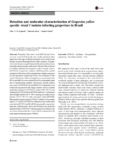Por favor, use este identificador para citar o enlazar este ítem:
http://www.alice.cnptia.embrapa.br/alice/handle/doc/1051941Registro completo de metadatos
| Campo DC | Valor | Lengua/Idioma |
|---|---|---|
| dc.contributor.author | FAJARDO, T. V. M. | pt_BR |
| dc.contributor.author | EIRAS, M. | pt_BR |
| dc.contributor.author | NICKEL, O. | pt_BR |
| dc.date.accessioned | 2016-08-29T11:11:11Z | pt_BR |
| dc.date.available | 2016-08-29T11:11:11Z | pt_BR |
| dc.date.created | 2016-08-29 | pt_BR |
| dc.date.issued | 2016 | pt_BR |
| dc.identifier.citation | Tropical Plant Pathology, Brasília, DF, v. 41, p. 246-253, July 2016. | pt_BR |
| dc.identifier.uri | http://www.alice.cnptia.embrapa.br/alice/handle/doc/1051941 | pt_BR |
| dc.description | Presently, Hop stunt viroid(HSVd) and Citrus exocortis viroid (CEVd) are the only viroids reported to infect grapevines (Vitis spp.) in Brazil, among the seven viroid species already reported infecting this host in other countries. All grapevine viroid diseases are graft-transmissible and can induce losses especially when associated with viruses. The aim of this work was to confirm infection by Grapevine yellow speckle viroid 1(GYSVd-1) in grapevine samples exhibiting yellow speckle symptoms in the leaves and in asymptomatic samples sequenced by next generation sequencing (NGS). The occurrence of this viroid in Brazil was further investigated in a second study. Total RNAs and dsRNAs were extracted from five symptomatic plants and 16 asymptomatic samples, respectively. Specific primers were used for RT-PCR and amplified DNA fragments were cloned and sequenced by the Sanger method. Eleven complete nucleotide sequences of GYSVd-1 isolates (366 ?367 nt) were obtained from NGS and from RT-PCR amplicons. Comparisons showed high identities (95.9 ?100 %) among ten isolates and an identity of 87.2 ?90.4 % with a divergent isolate (RM-BR). Phylogenetic analyses placed GYSVd-1 isolates in four clusters (types 1, 2, 3 and 4). All GYSVd-1 infections were confirmed by conventional RT-PCR and RT-qPCR using specific oligonucleo-tides and a labeled probe. This is the first report and molecular characterization of GYSVd-1 infecting grapevines in Brazil, and our survey indicates that this viroid could be widespread in the major grape producing regions of Brazil. Keywords GYSVd-1 . Incidence . Next generation sequencing. Secondary structure. Vine. | pt_BR |
| dc.language.iso | eng | pt_BR |
| dc.rights | openAccess | eng |
| dc.subject | Next generation | pt_BR |
| dc.subject | Secondary structure | pt_BR |
| dc.subject | GYSVd-1 | pt_BR |
| dc.subject | Vine | pt_BR |
| dc.title | Detection and molecular characterization of Grapevine yellow speckle viroid 1 isolates infecting grapevines in Brazil. | pt_BR |
| dc.type | Artigo de periódico | pt_BR |
| dc.date.updated | 2019-05-07T11:11:11Z | pt_BR |
| dc.subject.thesagro | Vinho | pt_BR |
| dc.subject.nalthesaurus | Incidence | pt_BR |
| dc.subject.nalthesaurus | Hop stunt viroid | pt_BR |
| dc.subject.nalthesaurus | Citrus exocortis viroid | pt_BR |
| riaa.ainfo.id | 1051941 | pt_BR |
| riaa.ainfo.lastupdate | 2019-05-07 -03:00:00 | pt_BR |
| dc.contributor.institution | THOR VINICIUS MARTINS FAJARDO, CNPUV; Marcelo Eiras, Instituto Biológico de São Paulo, 04014-002 São Paulo, SP, Brazil; OSMAR NICKEL, CNPUV. | pt_BR |
| Aparece en las colecciones: | Artigo em periódico indexado (CNPUV)  | |
Ficheros en este ítem:
| Fichero | Descripción | Tamaño | Formato | |
|---|---|---|---|---|
| TPPGYSVd1articlepublicadov41p2462532016.pdf | 608,01 kB | Adobe PDF |  Visualizar/Abrir |









